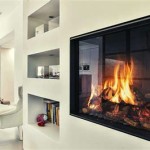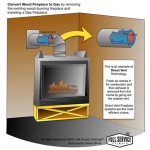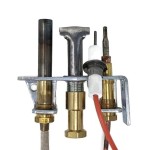Pilot Light Gas Fireplace Too High: Understanding and Troubleshooting
A pilot light on a gas fireplace is a small, continuous flame that serves as the ignition source for the main burner. It's a crucial component for the fireplace's proper operation. When the pilot light burns too high, it can lead to several problems, including inefficient gas usage, potential safety hazards, and damage to fireplace components. This article will explore the causes of an excessively high pilot light in a gas fireplace, the associated risks, and the steps to troubleshoot and resolve the issue effectively.
Understanding the Components and Function of the Pilot Light Assembly
The pilot light assembly is more than just a flame; it's a carefully calibrated system with several integrated parts. The components include the pilot light burner, the thermocouple or thermopile, and the gas supply tubing connecting to the gas valve. The pilot light burner is a small nozzle through which gas flows to create the flame. The thermocouple or thermopile is a safety device that generates a small electrical current when heated by the pilot flame. This current confirms the presence of the flame to the gas valve, allowing it to open and release gas to the main burner when the fireplace is turned on. If the thermocouple or thermopile doesn't sense a pilot flame, it cuts off the gas supply to prevent gas leaks.
The proper functioning of these components is essential for the fireplace's safe and efficient operation. When the pilot light is burning at the correct height, the thermocouple or thermopile is adequately heated, the gas valve operates as intended, and the risk of gas leaks is minimized. However, when the pilot light burns too high, it can put undue stress on the thermocouple or thermopile, potentially shortening its lifespan. It also introduces the risk of excessive heat buildup within the fireplace enclosure, which can damage other components.
Common Causes of a High Pilot Light
Several factors can contribute to a pilot light burning at an excessively high level. Identifying the root cause is crucial for implementing the correct solution.
Gas Pressure Fluctuations: Variations in the incoming gas pressure can directly impact the size of the pilot flame. If the gas pressure is higher than the system's designed parameters, the pilot light will naturally burn larger. This can be caused by issues within the municipal gas supply or problems with the gas regulator serving the house. A faulty gas regulator can allow excessive pressure to reach the fireplace, leading to an oversized pilot flame.
Dirty or Obstructed Pilot Orifice: The pilot orifice is a small opening in the pilot burner that precisely controls the amount of gas flowing to the pilot light. Over time, this orifice can become clogged with dust, debris, or corrosion. This blockage forces the gas to flow through a smaller opening, increasing its velocity and causing the pilot flame to burn higher and more erratically. The accumulation of soot and carbon deposits can also contribute to this problem.
Improper Adjustment of the Pilot Flame Regulator: Most gas fireplaces have a mechanism for adjusting the pilot flame height. This is usually a small screw located near the gas valve or pilot burner assembly. If this screw is improperly adjusted, it can cause the pilot flame to burn too high. Sometimes, this adjustment is accidentally altered during maintenance or cleaning of the fireplace.
Faulty Gas Valve: A malfunctioning gas valve can also be the source of the problem. The gas valve controls the flow of gas to both the pilot light and the main burner. If the valve is not functioning correctly, it may allow too much gas to flow to the pilot light, resulting in an excessively high flame. This is a serious issue that requires professional attention.
Troubleshooting and Corrective Actions
When dealing with a gas fireplace, safety should always be the primary concern. Before attempting any troubleshooting steps, ensure the gas supply to the fireplace is shut off. If there is any doubt about your ability to safely perform these tasks, consulting a qualified gas fireplace technician is strongly recommended.
Inspect and Clean the Pilot Orifice: Begin by carefully inspecting the pilot orifice for any signs of blockage or debris. Use a small wire or a specialized pilot cleaning tool to gently clear any obstructions. Avoid using overly abrasive materials that could damage the orifice. After cleaning, reassemble the pilot assembly and turn on the gas supply to observe if the pilot flame returns to a normal size.
Adjust the Pilot Flame Regulator: Locate the pilot flame adjustment screw and carefully turn it to reduce the flame height. Make small adjustments and observe the pilot flame after each adjustment until the desired flame size is achieved. The flame should be large enough to adequately heat the thermocouple or thermopile but not so large that it impinges on other fireplace components or produces excessive soot.
Check Gas Pressure: If the pilot flame remains too high after cleaning the orifice and adjusting the flame regulator, the gas pressure may be the problem. A qualified gas technician should be called to measure the incoming gas pressure to the fireplace. If the pressure is outside the acceptable range, the gas regulator upstream of the fireplace may need to be inspected or replaced. Do not attempt to adjust the gas regulator without proper training and equipment.
Professional Inspection and Repair: If the above steps do not resolve the issue, it is likely that there is a problem with the gas valve or other components within the fireplace. A qualified gas fireplace technician will be able to diagnose the problem accurately and perform the necessary repairs. The technician will have the specialized tools and knowledge to safely handle gas-related issues and ensure the fireplace is operating correctly.
Regular maintenance, including cleaning the pilot assembly and inspecting the gas valve, can help prevent issues with the pilot light and ensure the safe and efficient operation of the gas fireplace. Remember that addressing a high pilot light promptly can prevent further damage to the fireplace and minimize potential safety risks.

How Big Should Pilot Light Be On Gas Fireplace Beezzly

How Big Should Pilot Light Be On Gas Fireplace Beezzly

How To Test If Your Pilot Flame Is Bad Www Mygasfireplacerepair Com
Is It Okay If My Pilot Light Therma Coupler Red Hot When Having The On A Gas Fireplace Quora
What S The Proper Pilot Adjustment For Vs8420e 2024 Honeywell Lp Gas Valve Hearth Com Forums Home
How To Adjust The Pilot Light On Gas Logs Hunker
My Gas Fireplace Pilot Light Works Perfectly However When I Flip The Switch For Rest Of To Turn On Nothing Happens What Quora

How Much Gas Does A Pilot Light Use Per Hour Day Month Year Learnmetrics

Is It Okay To Leave A Pilot Light On For Gas Fireplace

Gas Fireplace Adjustment Without Hi Low Switch Doityourself Com Community Forums
Related Posts








